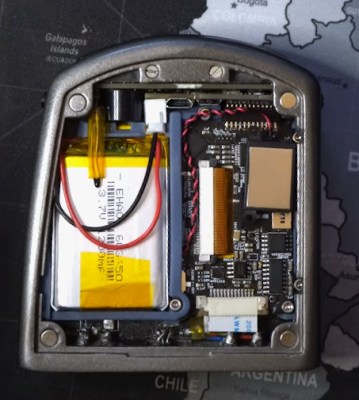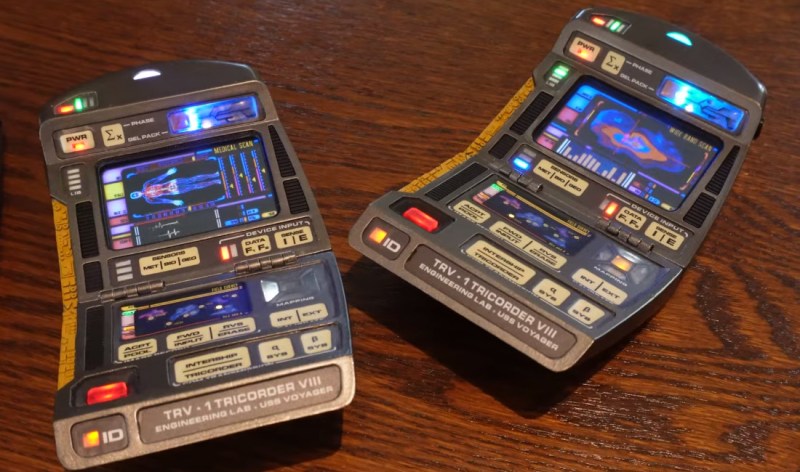For the last few years, [Mangy_Dog] has been working on what is easily the most technically and aesthetically impressive Star Trek tricorder prop the world has ever seen. With each new version of the hardware we’ve gotten the occasional peek under the hood or source code walk-through, but these limited presentations have made it somewhat difficult to really appreciate the scale of this undertaking.
But now thanks to this epic hour-long tour of the hardware and software that makes up version 2.5 of his Voyager tricorder, we can finally see just how incredible the engineering that’s gone into this project really is. Every detail has been meticulously considered to deliver a final product that’s not only as visually accurate as possible, but reliable enough to actually carry around.
 In the video, [Mangy_Dog] demonstrates how the new version of the tricorder can be dissembled with just a few common tools, which he felt was an important goal for the project so that it could be repaired and potentially even upgraded over time. Not that there’s much breathing room inside the enclosure for new goodies — the density of the internal electronics is astounding, perhaps the highest we’ve ever seen in a homebrew project like this.
In the video, [Mangy_Dog] demonstrates how the new version of the tricorder can be dissembled with just a few common tools, which he felt was an important goal for the project so that it could be repaired and potentially even upgraded over time. Not that there’s much breathing room inside the enclosure for new goodies — the density of the internal electronics is astounding, perhaps the highest we’ve ever seen in a homebrew project like this.
There’s seven separate PCBs in the top half of the tricorder alone, with the most important ones being (relatively) easy to remove should they require service. More electronics are hiding in the lower half of the device, but unfortunately those needed to be permanently sealed up in the case so as not to ruin the futuristic Trek aesthetic with unsightly screws or access hatches.
What we found particularly interesting was hearing about all the little bodges and fixes that he’s had to implement. Even after several hardware revisions, with the dizzying array of components packed into this build, the occasional goof is simply inevitable. [Mangy_Dog] points each one out, explains what the cause was, and shows how he implemented the repair. It’s an important reminder that, even in the most fantastically engineered projects, there’s always room to improve and sharpen your skills.
While three-quarters or so of the video’s total runtime is dedicated to going over the hardware, he does dedicate a bit towards the end towards the software that pulls it all together. Though he only goes through a few subroutines and functions, it’s clear that [Mangy_Dog] is just as adept with with the keyboard as he is with the soldering iron.

To close out the video he goes over some of the other projects hes working on, and knowing the level of detail and professionalism he brings to all of his creations, we can’t wait to see what he’s got in store for us next.
















I think it’s quite fascinating and admirable that the community of the Tricorder hobby/sub-genre has always been trying to go beyond making props. Most if in not all homebrewed Tricorders or Scanners (ENT) do have some sort of sensory, even if it’s just temperature and/or humidity. So they’re actually useful, even if they just prevent the cosplayers using them from catching a cold. ;)
I forgot to explain, this wasn’t meant as any kind of critique whatsoever. The Voyager Tricorder is kind of a special case, it’s one of these “holy grail” of model/props making, maybe. Making a sophisticated replica that looks authentic is hard already. Functionality, if needed, could be added at a later point via software update. So kudos to the builder! 😎👍
With technology improving ever more interesting sensors could be added. e.g. smell, etc.
Ahaha. Good luck with that. It smells fishy.
The *unused* Voyager Tricorder? Making a functional version of a screen used prop is a high goal, but doing it for a prop that never actually made an on-screen appearance is next level.
“he only goes through a few subroutines and functions”
🤓
Nice touch! It’s always amused me how much software engineering in the 24th century sounds like the 1960s in its obsession with subroutines.
That’s because ALGOL-60 and similar languages were common when TOS was new, I guess.
Back in the 60s, keyboard based input on mainframes wasn’t so common, also.
There were punch cards and punch tapes, rather.
Electric typewriters (Telex machines) existed, too, but weren’t the primary inpzt method.
Same goes for glass terminals.
They technically existed (see Andromeda Strain movie), but were not common.
Simple speech synthesis was still a reality in the 60s,too.
That’s why on the NCC1701 most information input/output is done via voice command, switches or via cassettes (modules) rather.
The sub routine thing is also related to this, maybe.
Before the mid-90s, procedural programming style was still common.
This was before object-oriented or even object-based programming took over.
Procedural programming focuses on the solution of a problem, rather than on objects.
Quick Basic, Turbo Pascal and Visual Basic Classic support both.
That’s roughly when both programming principles clashed together.
Interesting you mention telex machines, when the computer spoke in TOS the the sound of a telex machine way overlaid on the speech, check it out next time you watch a TOS episode.